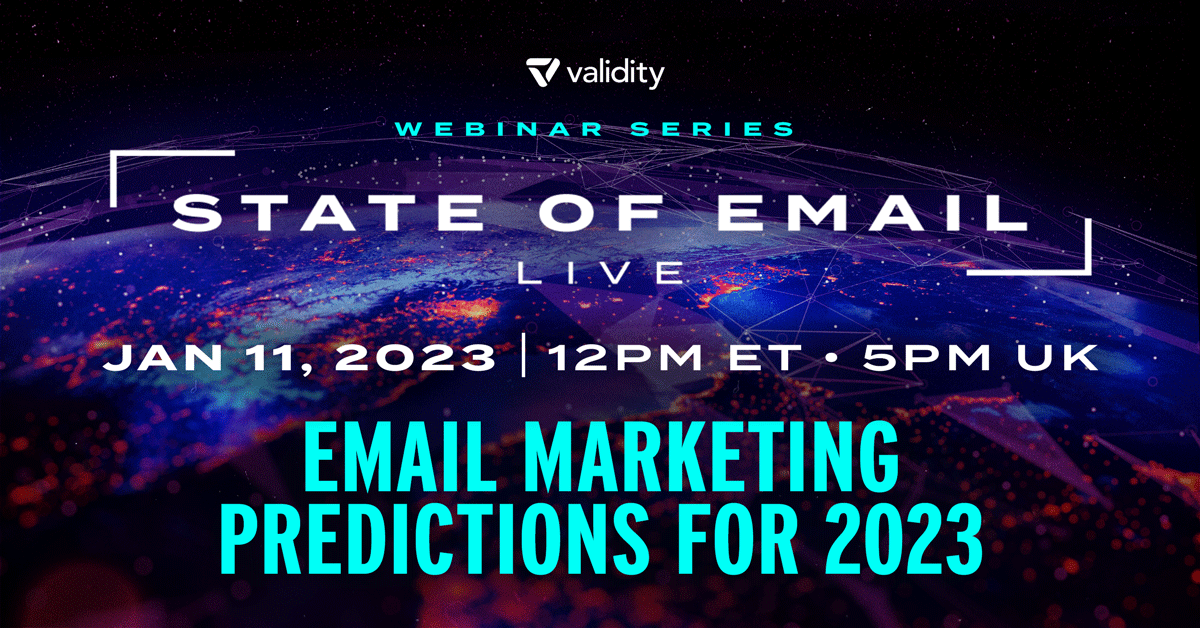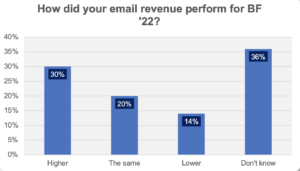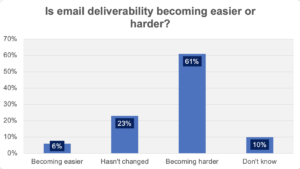Email Marketing
What’s Next for Email? Three Email Marketing Leaders Share Their Predictions for 2023
minute read

It’s the question on every email marketer’s mind: What’s in store for 2023?
Now that 2022 is done and dusted, it’s time to look ahead.
In our latest edition of State of Email Live, I spoke with three heavy-hitters in the world of email marketing: Clifford McGowen, Director of Digital Marketing Content and Delivery at insurance provider Nationwide, Magnus Eén, Deliverability Manager at EU home and living company Westwing Group, and Glenn Paster, Email Marketing Director at specialty lifestyle brand retailer Potpourri Group.
They shared their major takeaways from 2022, plus sneak previews of what email marketers can expect this year. Read on for an overview of their responses.
What did you observe on Black Friday/Cyber Monday and how does this shape your strategy in 2023?
The majority of our State of Email webinar attendees seemed to enjoy robust performance over this critical period, with 30 percent of attendees reporting their Black Friday email revenue was higher than ever.

Here’s what our guests had to say:
Clifford McGowen: Since Nationwide isn’t a retail company, we don’t purposefully send email communications to our subscribers on Black Friday and Cyber Monday. There will be enough noise in the inbox and no need for us to clutter it even further. Our audience isn’t looking for insurance thought leadership on those days—they want flash deals on things they can cross off their holiday shopping lists, not their retirement or personal liability lists. The recessionary climate means we want to drive value by leading conversations offering solutions to mitigate risk and alleviate concerns tied to changing economic environments. We can’t avoid communication during this time, but we can be very selective with the “who” and the “what.”
Glenn Paster: Industry-wide, Black Friday/Cyber Monday online sales were soft. Not bad…soft. The need to begin promos earlier than in past years spread out the Black Friday/Cyber Monday revenue impact, as did higher than expected inventory levels and higher discounts offered by our competitors. We did see excellent results from smaller flash sales, which we will continue in 2023. This will make for some interesting 2023 holiday discussions and strategies, beginning in January.
Magnus Eén: Since Westwing is a public company, I can’t disclose any Black Friday results. However, a personal observation is that more European retailers took a stand against Black Friday marketing this year, with some even closing their sites for the day. While this might be a risky move, it does demonstrate healthy respect for consumer preferences.
What is the biggest emerging trend you’ve observed in 2022, and how will it impact your program in 2023?
Clifford McGowen: As email continued to perform well at our organization, people expected us to send more and more of it. This shifted us towards simplicity to meet the pressures and demands of our large enterprise. In 2022, we sent 40 percent more emails than the previous year. I recall back in 2019, when we did about 50 projects a month with about 10 builders. Now we do over 160 a month with the same number of builders, which forces us to make our processes leaner.
We didn’t reach the point of sending plain text emails only, but we did template and standardize as much as we could. We also shifted from one-off messaging to a newsletter approach, and relied more heavily on journeys—which we’ll continue to do in 2023. Above all, we needed to send messages people wanted to see so we didn’t abuse the channel.
Magnus Eén: The biggest changes to our email program occurred because of Apple’s Mail Privacy Protection (MPP). We’re finally seeing its long-term effects. We’ve always segmented our sends heavily and have had to re-work our logic in the wake of the new policy. Consequently, key performance indicators changed and we’ve shifted our mindset to pay closer attention to “real” customer engagement, not just how many tracking pixels fired. While this is more work, it gives our customers a much better user experience.
Glenn Paster: I agree Apple’s MPP was pivotal—it threw a wrench into the entire industry. I don’t measure opens at all anymore. They’re almost irrelevant. We focus more on unique clicks, but even these are less reliable. The challenges Apple presented posed new questions in terms of how we can best leverage first-party data. We’re incredibly careful with how we use it.
We send nearly four billion emails per year (bulk and event-based messages). I’m looking to send more trigger-based versus bulk email in 2023. Currently, I have over 85 trigger programs, up from just 18 when I started in 2015.
Do you have a favorite piece of new marketing technology heading into 2023?
Clifford McGowen: Validity’s BriteVerify. Recently we saw high inactivity from our Independent Insurance Agent subscribers for a newsletter we deploy monthly. Sales promised these were accurate email addresses and our email preference center did too. We ran our list through BriteVerify and determined the emails were indeed accurate, but there was likely a firewall preventing our emails from reaching the IA’s inboxes. This allowed us to pivot accordingly and partner with sales to manage our campaigns differently going forward.
Glenn Paster: We are now using a SMS/MMS business partner to enhance our email sends. This has proven ‘real-world’ helpful, especially with managing and reimagining the timing of abandonment (browse and cart) email sends.
Magnus Eén: Perhaps this isn’t a “new” technology, but I’m looking forward to seeing what the mobile Yahoo Mail App does in 2023. Last year, they were at the forefront of innovation, showing what a modern email client could and should look like. They focused on user experience, and we as email marketers should do the same. The app makes the most of many emerging technologies like Brand Indicators for Message Identification (BIMI), metadata/schema, and AI.
What’s the best piece of email marketing you saw in 2022? What made it so effective for you?
Clifford McGowen: Vimeo—or anything GIF related. I’ve been pushing our marketing partners to use GIFs more to convey messages without requiring subscribers to read copy in the traditional way. I love replacing our banners with GIFs. I look at emails as billboards. GIFs are similar to digital ads, but come at virtually no cost. Plus, Outlook updates have made GIFs scalable across all major email clients, so that hurdle is gone.
Magnus Eén: Spotify’s concert recommendations are spot on. I don’t feel tracked, as I have chosen my location in the app. They combine my data and make targeted recommendations, all while making me feel as if the company is doing me a favor—a sign of great marketing.
Will deliverability get harder in 2023?
Clifford McGowen: It sure feels like it will. The best way to handle this is to assume the worst. Before you create and deploy an email, pretend you are an email client gatekeeper (not AI-based) whose job is pre-screening emails to decide if they are worth reading or deleting. Reward your team members for reconsidering an email. If there is debate or discussion, don’t send it. Mailbox providers are trying their best to mitigate abuse. Rather than think of them as the “bad wolf,” we should applaud their efforts and do our best to help.
Glenn Paster: Absolutely. Mailbox providers are blocking legitimate email and filtering reputable senders to spam. Senders need to be more agile than ever just to stay on par with inbox placement they enjoyed in the past.
Magnus Eén: My short answer is no. However, marketers will need to work harder to maintain good deliverability. As always, positive subscriber engagement will be key, and data quality will be increasingly important. Keep an eye on your data and use tools to clean your lists rather than relying on human hands.
Our State of Email webinar attendees agreed with Glenn and Clifford. Over 61 percent said that email deliverability is becoming harder.

What’s your top email prediction for 2023?
Clifford McGowen: Email still isn’t dead. On the contrary, it is and will continue to be a top-performing channel in any marketing mix. Audience sizes and subscribership may get smaller, but the subscribers that stay will be better quality as people continue updating their email preferences. As this happens, email marketers need to accept that volume isn’t king—quality is!
Glenn Paster: The email channel will continue to be the channel for communication and revenue. I also predict email marketers will need to rethink the time they send emails. We needed to shift our timing during COVID-19, and again when people returned to the office. In 2023, we must keep a close eye on when subscribers are most likely to engage with our emails in this new work climate.
Magnus Eén: As the global economic situation gets more precarious, companies will focus more on what they know retains or provides value. Email marketing, with its proven ROI, will further increase in importance.
For even more predictions about the fate of email in 2023, tune into our next episode of State of Email Live: “Email Marketing Predictions for 2023.”